Understanding Hegemonic Masculinity
Hegemonic masculinity refers to the dominant form of masculinity that is culturally exalted. It encompasses traits such as aggression, control, and emotional restraint, often positioning men in a place of power over women and marginalized groups. This power dynamic facilitates an environment where violence against women is normalized and often perpetuated.
The Impact of Societal Norms
Societal norms heavily influence individual behaviors and attitudes towards gender roles. In many cultures, traditional masculinity is celebrated, which can lead to a toxic environment for both men and women. These norms can perpetuate the idea that violence is an acceptable way for men to assert dominance over women.
Violence as a Tool of Control
Violence against women is often employed as a method of maintaining control and power. Hegemonic masculinity nurtures the belief that men should assert authority physically and emotionally. This behavior not only harms women but also reinforces harmful stereotypes about masculinity.
The Cycle of Violence
The cycle of violence often perpetuates itself within communities and families. When violence against women is witnessed or accepted as normal behavior, it can lead to a continuation of these patterns across generations. Breaking the cycle requires a critical examination of masculinity and its relationship to power and control.
Challenging Hegemonic Masculinity
Efforts to challenge hegemonic masculinity are vital in addressing violence against women. Education and awareness programs that promote alternative forms of masculinity can reduce aggression and encourage healthier expressions of identity. These initiatives aim to redefine masculinity in a way that fosters respect and equality.
The Role of Community and Policy
Community engagement and policy changes are essential in combating violence against women. Organizations and advocacy groups play a pivotal role in creating supportive environments for victims of violence. For more information on how hegemonic masculinity influences violence against women, refer to this resource: Hegemonic Masculinity and Violence Against Women.
Conclusion
Addressing hegemonic masculinity is crucial for the prevention of violence against women. By redefining societal norms and promoting healthier expressions of masculinity, we can create safer environments for everyone. Ultimately, the fight against violence is intertwined with the movement to redefine masculinity itself.

